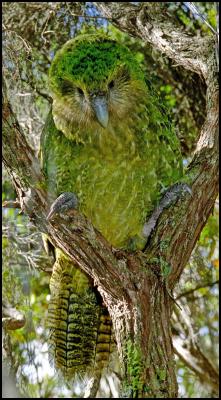Kakapo breeding season - update
4 March 2005
Kakapo breeding season - update

With the kakapo breeding season now in full flight, the Department of Conservation islooking ahead to do more research into improving breeding success.
Of six nests with 16 eggs between them on Codfish Island/Whenua Hou, only four or five were fertile, DOC national kakapo team member Vivienne Parker said today.
“We have had 14 matings involving nine females this year so far, and we are expecting more nests over the next couple of weeks.”
In an update of the kakapo programme completed earlier this week, DOC veteran kakapo scientist Don Merton said that goals had been exceeded during the 10-year life of the current kakapo recovery plan 1995-2005.
“It is appropriate now to set in place new directions and goals for the next decade (2006-2016). The review team’s report, due in June this year, will serve as a basis for the new plan.”
Among new areas of kakapo research are work on improving genetic diversity within the 83-strong kakapo population and the relationship between rimu fruiting and triggering of breeding behaviour.
This summer staff and volunteers have been testing whether it is the eating of green or unripe fruits that cause kakapo to initiate breeding behaviour, such as the construction of “track-and-bowl systems” which the males use for making their courtship booming calls.
Half of the adult females and some males that are genetically under-represented in the kakapo gene pool were fed green walnuts, while green pine conelets were fed to the remaining females and males on Whenua Hou during a trial lasting from early November 2004 to early February 2005.
“We are, as yet, uncertain what sparked breeding this year, but if in fact it was the green supplementary foods, then this will represent an important break-through,” Mr Merton said.
Kakapo were more likely to breed during years of heavy rimu fruiting and the programme would benefit greatly if breeding could be induced every year, he said.
Breeding last occurred in 2002 when a record 24 chicks hatched. This year’s season would be unlikely to reproduce these numbers because less natural food was available.
Last year’s move of juveniles and some adults was designed to improve the gene pool of kakapo, and improve the fertility percentage in eggs. Felix, a male who has sired 30 per cent of all kakapo alive today, was moved to Chalky Island/Te Kakahu in Fiordland to increase the chances of other males on Whenua Hou fathering offspring.
The Kakapo Recovery Programme has been
sponsored by Comalco since 1990, through the Treasured
Species Trust administered by the Royal Forest and Bird
Protection Society, the New Zealand Conservation Authority
and DOC. For more information, see
http://www.kakaporecovery.org.nz.
Kakapo
facts:
Kakapo are ground-dwelling parrots. They are excellent climbers, using their beak and claws to climb high into trees.
Kakapo are essentially flightless, capable of no more than short, wing-assisted jumps.
They are the world’s biggest parrots, weighing up to 4 kg.
In the breeding season, male kakapo swell up like a porcupine fish and emit a low booming sound that can travel up to 5km.
Kakapo look like green owls and move on the ground with a rolling gait.
They emit a strong fruity smell.
Kakapo are nocturnal and solitary, gathering only to breed.
The birds feed on seeds and fruits. It is believed that breeding is triggered by eating green rimu fruit.
They are very long lived. Richard Henry, the last surviving Fiordland bird, is believed to be at least 50 years old.
A female kakapo may lay a clutch of between one and three eggs. In exceptional years, for example in 2002, kakapo may lay two clutches in one breeding season.
Kakapo take many years to reach breeding maturity. Males will take five years, and females, nine to 11 years.
ENDS


 IRANZ: Budget Reaction – Time To Back Science With Long-Term Investment
IRANZ: Budget Reaction – Time To Back Science With Long-Term Investment Better Taxes for a Better Future: Budget Of Austerity Piles On Least Well-Off, Misreads Public Mood
Better Taxes for a Better Future: Budget Of Austerity Piles On Least Well-Off, Misreads Public Mood Nicola Gaston, The Conversation: NZ Budget 2025 - Science Investment Must Increase As A Proportion Of GDP For NZ To Innovate And Compete
Nicola Gaston, The Conversation: NZ Budget 2025 - Science Investment Must Increase As A Proportion Of GDP For NZ To Innovate And Compete Maritime Union of New Zealand: Maritime Union Condemns Threatened Job Losses On Aratere Ferry
Maritime Union of New Zealand: Maritime Union Condemns Threatened Job Losses On Aratere Ferry Science Media Centre: Proposed Increase To Glyphosate Limits – Expert Reaction
Science Media Centre: Proposed Increase To Glyphosate Limits – Expert Reaction Electricity Authority: Welcomes Plan For Boosting Consumer-Supplied Flexibility
Electricity Authority: Welcomes Plan For Boosting Consumer-Supplied Flexibility


